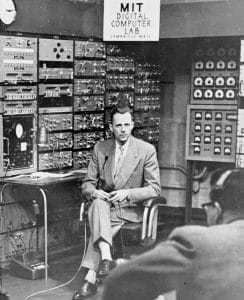Growing up on a cattle ranch in Nebraska, Forrester was interested in electricity, in part because the ranch didn’t have any. He built a wind generator from old car parts, and went on to study electrical engineering at the University of Nebraska-Lincoln, and went on to graduate school at the Massachusetts Institute of Technology. He never left MIT: he spent his entire career there. He studied system dynamics, which “uses computer simulation to take the knowledge we already have about details in the world around us and to show why our social and physical systems behave the way they do,” he said. But first, digital computers were needed. He started in 1940, in MIT’s then-new Servomechanisms Laboratory, researching servomechanism theory and feedback control systems. Early computers used relays or mechanical counters for memory, so memory was severely limited by power consumption and physical size. In the late 1940s, Forrester was the head of MIT Lincoln Laboratory’s Digital Computer Division, where he lead the development of the Whirlwind computer for the U.S. Navy to do real-time dynamic simulations. The team learned of efforts to use magnets to replace mechanical memory: by using tiny magnetic toroid “cores” (rings), wires routed through the rings could send current in one direction to set the memory (a “1”), or in the other direction to erase that bit (a “0”), while other wires read whether that bit was a 1 or a 0. Forrester perfected the idea in 1949, and was awarded the patent for core memory. A 32×32 core memory module, which was wired by hand, could store 1,024 bits — a massive reduction in size but a big jump in capacity. Core memory was used until the 1970s, when silicon chips replaced it, but the term is still around: a computer crash is still sometimes called a “core dump.”

The real power was when Forrester’s ideas came together. “Here you have a man who starts as an electrical engineer, so he understands current flowing down wires and charge accumulating in capacitors,” explained David C. Lane of England’s University of Reading. “Then he moves into servomechanisms and feedback control. Then he makes this remarkable imaginative leap, which is that those ideas are a way of threading together parts of a system, all connected by feedback loops. And once you start thinking like that, you’ve created an entirely new way of thinking” — system dynamics. Forrester published his textbook Industrial Dynamics, based on modeling a troubled General Electric appliance factory, in 1961. He then expanded his ideas to Urban Dynamics in 1969, and expanded his ideas again to World Dynamics in 1971 — an integrated simulation model of population, resources, and economic growth. “Simulations of dynamic systems are now indispensable throughout the physical and social sciences,” said John Sterman of the MIT Sloan School of Management — and indeed the Jay W. Forrester professor of management. “Not just in management, but also, for example, in astrophysics, biology, chemistry and climate change.” Forrester’s work “launched the field of global modeling,” Sterman says. “Jay developed the first model that treated interactions of population, the economy, natural resources, food and pollution in the context of the world as a whole.” Forrester died November 16, from prostate cancer. He was 98.
